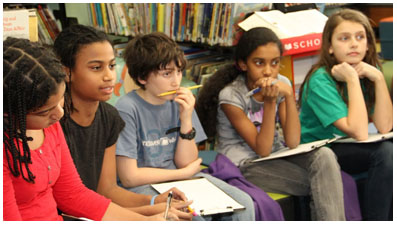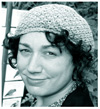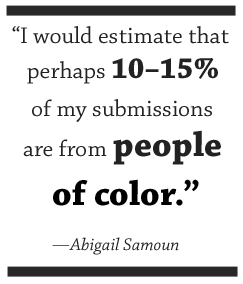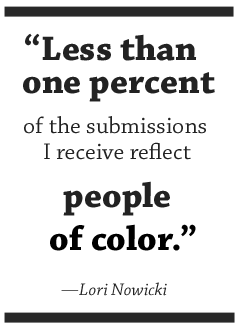 Since its release, the Diversity Baseline Survey (DBS) has become the most visited blog post we have ever produced. The DBS has been widely read and written about, and has opened up a renewed interest in how to improve staff diversity in the publishing industry. In our first piece, Behind the Scenes of Publishing’s First Diversity Baseline Survey, we covered the methodology and obstacles we faced conducting the survey. In this piece we will shed light on what happens next—and what’s already happening to improve the numbers. Continue reading
Since its release, the Diversity Baseline Survey (DBS) has become the most visited blog post we have ever produced. The DBS has been widely read and written about, and has opened up a renewed interest in how to improve staff diversity in the publishing industry. In our first piece, Behind the Scenes of Publishing’s First Diversity Baseline Survey, we covered the methodology and obstacles we faced conducting the survey. In this piece we will shed light on what happens next—and what’s already happening to improve the numbers. Continue reading
Tag Archives: Middle Eastern
Why We’re Asking Publishers to Join Our Diversity Baseline Survey
 If you’ve been following us for a while, you know that over the past few years we’ve released a series of infographics about the diversity gap in different industries including publishing, film, television, theater, and politics. Our infographic studies were designed to give people who were unfamiliar with issues of race and gender a sense of how deep the diversity problem goes in the United States and how entrenched these issues are in every facet of media. Continue reading
If you’ve been following us for a while, you know that over the past few years we’ve released a series of infographics about the diversity gap in different industries including publishing, film, television, theater, and politics. Our infographic studies were designed to give people who were unfamiliar with issues of race and gender a sense of how deep the diversity problem goes in the United States and how entrenched these issues are in every facet of media. Continue reading
The Diversity Gap in Silicon Valley
Silicon Valley has been the darling of the US economy for decades. Creativity, leadership, risk taking, and hard work are all attributes of American innovation at its finest. Though lauded as a true meritocracy by the business world, the truth is that Silicon Valley that suffers from a similar lack of representation among women and people of color as other industries. In our past Diversity Gap studies of the Academy Awards, the Tony Awards, the Emmy Awards, the children’s book industry, The New York Times Top 10 Bestseller List, Sci-Fi and Fantasy Films, and US politics, we have shown that there is a disturbingly consistent lack of diversity across the boards.
Continue readingWhere’s the Diversity, Hollywood? Sci-Fi and Fantasy Blockbusters Overwhelmingly White, Male
Summer blockbuster season is in full swing. For many moviegoers, that means escaping to a galaxy far, far away—or perhaps just a different version of our own planet Earth—through science fiction and fantasy movies. As fans clamor for the latest cinematic thrills, we decided to focus our next Diversity Gap study on the level of racial and gender representation in these ever-popular genres that consistently rake in the big bucks for movie studios. We reviewed the top 100 domestic grossing sci-fi and fantasy films as reported by Box Office Mojo. The results were staggeringly disappointing, if not surprising in light of our past Diversity Gap studies of the Tony Awards, the Emmy Awards, the children’s book industry, The New York Times Top 10 Bestseller List, US politics, the Academy Awards, and Silicon Valley where we analyzed yearly/multi-year samplings and found a disturbingly consistent lack of diversity.
Continue readingWhere’s the Diversity, Hollywood? 85 Years of the Academy Awards
Note: This infographic was updated to reflect winners through 2015.
The Academy Awards will soon unveil the very best in filmmaking in 2014. As the prediction chatter ricochets around the web, our curiosity about the level of racial and gender representation of the Academy Awards is the focus of our next Diversity Gap study. We reviewed the Academy’s entire 85-year history and the results were staggeringly disappointing, if not surprising in light of our past Diversity Gap studies of The Tony Awards, The Emmy Awards, the children’s book industry, The New York Times Top 10 Bestseller List, Sci-Fi and Fantasy Films, US politics, and Silicon Valley where we analyzed yearly/multi-year samplings and found a disturbingly consistent lack of diversity. Continue reading
Illustrator Christiane Krömer Takes Us Behind the Art of King For A Day
Just released last month, our newest picture book, King For a Day, takes readers on a colorful journey through the spring kite festival Basant. From a rooftop in Lahore, Pakistan, Malik is determined to take his kite Falcon out and win the most kite battles to earn the title of “King of Basant.”
Illustrator Christiane Krömer used paper and fabric collage to create the gorgeous illustrations you see below:
 I always take photos of the many stages. That way I can see what a picture looked like earlier on, experiment with many choices and then maybe go back to an earlier option. The fun with collage is that you can always push all the paper pieces and fabrics around until they are in the right spot. But there is also a big danger that all the 1000 loose pieces go flying, so it’s a good idea to have a photo that tells you exactly how it was when it looked good. I always have real fun to look at all the stages once the illustrations are finished. I hope you do, too.
I always take photos of the many stages. That way I can see what a picture looked like earlier on, experiment with many choices and then maybe go back to an earlier option. The fun with collage is that you can always push all the paper pieces and fabrics around until they are in the right spot. But there is also a big danger that all the 1000 loose pieces go flying, so it’s a good idea to have a photo that tells you exactly how it was when it looked good. I always have real fun to look at all the stages once the illustrations are finished. I hope you do, too.
Where’s the Diversity? The NY Times Top 10 Bestsellers List
As we near the end of the 2013, we enter the season when major newspapers and magazines release their “Best of [enter year] lists”. So naturally we were curious about the level of representation of authors of color in last year’s New York Times Top 10 Bestsellers list. We chose to look at their most general bestsellers list, Combined Print & E-Book Fiction (adult), and looked at the top ten books for all 52 weeks of 2012. The results were staggering, if not surprising in light of our past Diversity Gap studies of the Academy Awards, The Tony Awards, The Emmy Awards, the children’s book industry, Sci-Fi and Fantasy Films, US politics, and Silicon Valley where we analyzed yearly/multi-year samplings and found a disturbingly consistent lack of diversity. Continue reading
Whitewashing Book Covers: A Trip to Barnes & Noble Part II
 Allie Jane Bruce is Children’s Librarian at the Bank Street College of Education. She
Allie Jane Bruce is Children’s Librarian at the Bank Street College of Education. She ![]() began her career as a bookseller at Politics and Prose bookstore in Washington, DC, and earned her library degree from Pratt Institute. She tweets from @alliejanebruce and blogs at Bank Street College.
began her career as a bookseller at Politics and Prose bookstore in Washington, DC, and earned her library degree from Pratt Institute. She tweets from @alliejanebruce and blogs at Bank Street College.
Part 1 | Part 2

Over the course of the last academic year, I co-taught a year-long unit that allowed a sixth-grade class to explore prejudices in books and the book industry. After studying how book covers and content can marginalize groups (we studied treatments of race, ethnicity, gender, body image, sexuality, class, ability, and more), we took a field trip to Barnes & Noble—by far my favorite piece of the project. The kids exited the store with steam issuing from their ears.

Whitewashing Book Covers: What Do Kids Think? Part I
 Allie Jane Bruce is Children’s Librarian at the Bank Street College of Education. She
Allie Jane Bruce is Children’s Librarian at the Bank Street College of Education. She ![]() began her career as a bookseller at Politics and Prose bookstore in Washington, DC, and earned her library degree from Pratt Institute. She tweets from @alliejanebruce and blogs for Bank Street College.
began her career as a bookseller at Politics and Prose bookstore in Washington, DC, and earned her library degree from Pratt Institute. She tweets from @alliejanebruce and blogs for Bank Street College.
Part 1 | Part 2
In my first year as Children’s Librarian at Bank Street, I worked with two teachers on a project that allowed sixth-graders to explore implicit and explicit biases in publishing. Using book covers as a starting point for discussion, we engaged in conversations about identity, race, ethnicity, sexual orientation, gender, body image, class, and ability as they relate to books and beyond.
Literary Agents Discuss the Diversity Gap in Publishing
Literary agents make up a big part of the publishing machine. Most publishers no longer consider unsolicited submissions, so an agent is a must if you even want to get your foot in the door. Each year, agents review many promising manuscripts and portfolios so it is safe to say they have a good sense of who makes up the talent pool of children’s book publishing. So what kind of diversity are agents seeing? Being that the number of diverse books has not increased in the last eighteen years, in order to understand why this problem persists we decided to ask the gatekeepers.
 Adriana Domínguez is an agent at Full Circle Literary, a boutique literary agency based in San Diego and New York City, offering a unique full circle approach to literary representation. The agency’s experience in book publishing includes editorial, marketing, publicity, legal, and rights, and is used to help build authors one step at a time. Full Circle works with both veteran and debut writers and artists, and has a knack for finding and developing new and diverse talent.
Adriana Domínguez is an agent at Full Circle Literary, a boutique literary agency based in San Diego and New York City, offering a unique full circle approach to literary representation. The agency’s experience in book publishing includes editorial, marketing, publicity, legal, and rights, and is used to help build authors one step at a time. Full Circle works with both veteran and debut writers and artists, and has a knack for finding and developing new and diverse talent.

 Karen Grencik and Abigail Samoun own Red Fox Literary, a boutique agency representing children’s book authors and illustrators. They offer a dazzling array of talents among their roster of clients, including New York Times and Time magazine Best Book winners, and some of the most promising up-and-coming talents working in the field today. The agency is closed to unsolicited submissions but it does accept queries from attendees at conferences where they present or through industry referrals.
Karen Grencik and Abigail Samoun own Red Fox Literary, a boutique agency representing children’s book authors and illustrators. They offer a dazzling array of talents among their roster of clients, including New York Times and Time magazine Best Book winners, and some of the most promising up-and-coming talents working in the field today. The agency is closed to unsolicited submissions but it does accept queries from attendees at conferences where they present or through industry referrals.
 Lori Nowicki is founder of Painted Words, a literary agency that represents illustrators and authors in the children’s publishing marketplace and beyond. Their goal is to provide the utmost in representation for illustrators and writers while placing a unique emphasis on developing characters, books, and licensed properties.
Lori Nowicki is founder of Painted Words, a literary agency that represents illustrators and authors in the children’s publishing marketplace and beyond. Their goal is to provide the utmost in representation for illustrators and writers while placing a unique emphasis on developing characters, books, and licensed properties.
Do you receive many submissions from authors and illustrators of color? Overall, what percentage of authors and illustrators who submit to you are people of color? Note: Estimations are fine.
AD/Full Circle: I honestly wouldn’t know about percentages, but our agency receives a good number of submissions from authors of color. Proportionally, our agency represents more authors of color than most others. Authors and illustrators who are familiar with our work and/or visit our website know that we welcome diverse points of view, and see that diversity represented in our client list. I will say that I have personally felt for a very long time that there are simply not enough illustrators of color in the marketplace, and I am not quite sure why that is. I am usually very enthusiastic when I receive a query from a talented author/illustrator of color—I wish we received more of those! As a general rule, our agency represents illustrators who are also writers, and such people are difficult to find under any circumstances, as not everyone is equally good at both.
AS/Red Fox Literary: It’s hard to tell how many submissions come from authors and illustrators of color. Most of the time, I haven’t met these authors and illustrators in person so the only way for me to tell what their ethnicity might be is by their name and their choice of subjects, but these can be misleading. I once made an offer on a picture book about an African American family, told in language with a jazzy rhythm, by an author with an African American sounding name and she turned out to be a white librarian. I’d made the assumption, based on the subject and the author’s name, that she would be African American.
Oftentimes, the question of the author’s ethnicity doesn’t enter my mind—unless the subject relates to race, in which case I’ll wonder if the author will have the life experience that can provide a genuine insider’s point-of-view. I would estimate that perhaps 10–15% of my submissions are from people of color.
KG/Red Fox Literary: I have four authors of color on my list of 38 authors, but like Abi says, we never know the ethnicity of an author when they submit to us. The only way I could imagine to gauge it would be by determining how many authors of color attend an SCBWI conference at which I present, comparing that number to the total number of attendees, and then assuming the ratio of submissions to be a similar percentage. At the recent summer conference in LA, I would guesstimate that authors of color made up about 35% of the total number of attendees.

